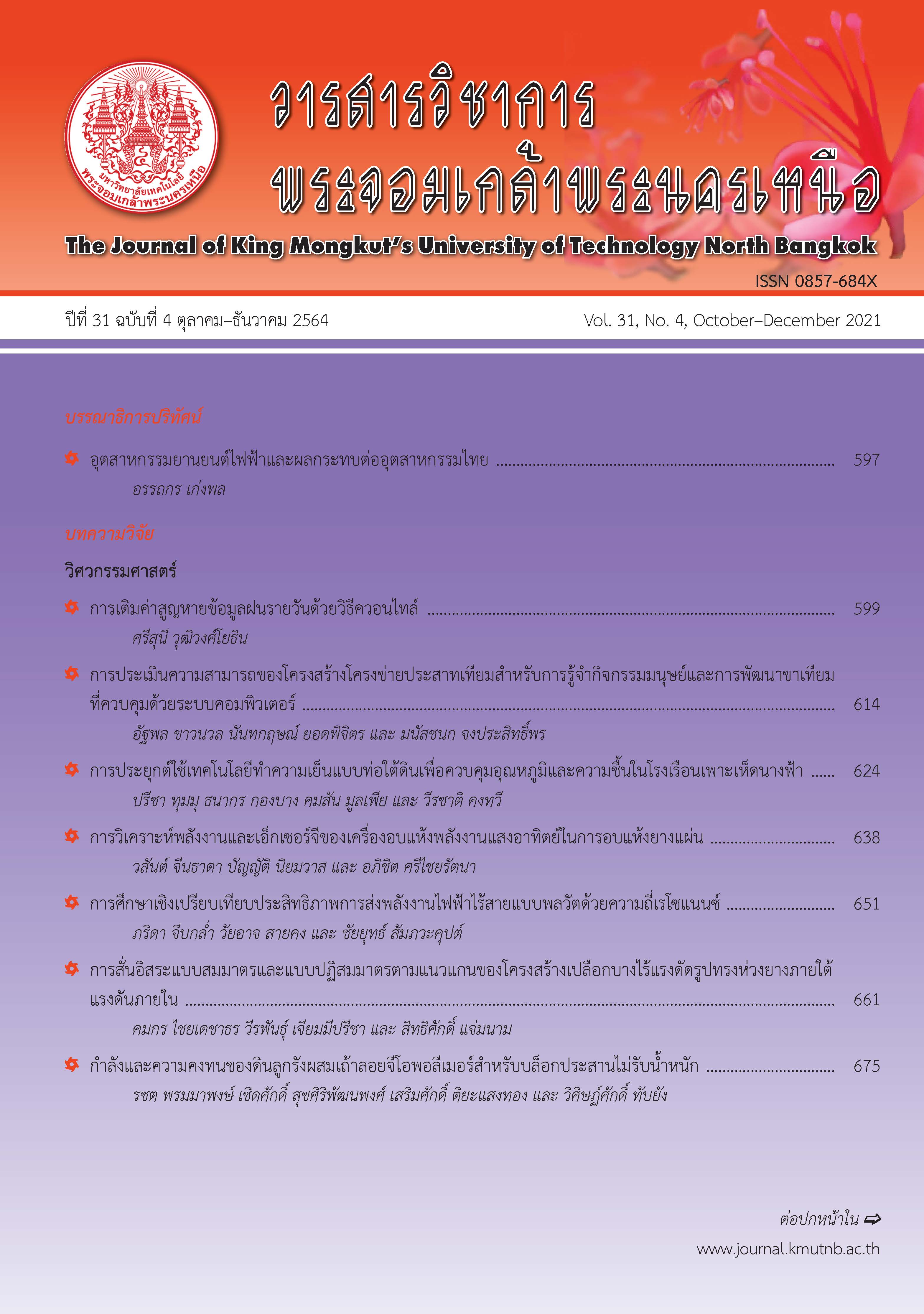กำลังและความคงทนของดินลูกรังผสมเถ้าลอยจีโอโพลีเมอร์สำหรับบล็อกประสานไม่รับน้ำหนัก
Main Article Content
บทคัดย่อ
งานวิจัยนี้ศึกษากำลัง และความคงทนของดินลูกรังผสมเถ้าลอยจีโอโพลีเมอร์ โดยใช้อัตราส่วนดินลูกรังต่อเถ้าลอยเท่ากับ 3:1 อัตราส่วนโซเดียมซิลิเกต (Na2SiO3) ต่อโซเดียมไฮดรอกไซด์ (NaOH) เท่ากับ 80:20, 70:30 และ 50:50 ความเข้มข้นของ NaOH มีค่าเท่ากับ 1, 3 และ 5 โมลาร์ (M) และอายุบ่ม 7, 14, 28, 60 และ 90 วัน โดยทำการทดสอบการบดอัด กำลังอัดแกนเดียว กำลังดัด และความคงทนที่สภาวะเปียกสลับแห้งของดินลูกรังผสมเถ้าลอยจีโอโพลีเมอร์ พบว่าอัตราส่วน Na2SiO3:NaOH และความเข้มข้นของ NaOH มีผลต่อหน่วยน้ำหนักแห้ง กำลังอัดแกนเดียว กำลังดัด และความคงทนของตัวอย่าง หน่วยน้ำหนักแห้งสูงสุด และปริมาณสารกระตุ้นที่เหมาะสมของตัวอย่างมีค่าเท่ากับ 19.01 kN/m3 และร้อยละ 18 ตามลำดับ กำลังอัดและกำลังดัดสูงสุดของตัวอย่างพบที่อัตราส่วน Na2SiO3:NaOH เท่ากับ 80:20 และความเข้มข้นของ NaOH เท่ากับ 5 M ที่อายุบ่ม 28 วัน มีค่าเท่ากับ 6.55 และ 2.70 MPa ตามลำดับ ค่ากำลังอัดสูงกว่าเกณฑ์มาตราฐานประมาณ 2.62 เท่า ปริมาณ NaOH ส่งผลกระทบต่อกำลังอัด การดูดซึมน้ำ และร้อยละการสูญเสียน้ำหนักของตัวอย่าง ปริมาณ NaOH ที่สูงขึ้นสามารถชะซิลิก้าได้ดีเมื่อได้รับความร้อน ซึ่งทำให้ตัวอย่างมีความแน่นมากขึ้น
Article Details
บทความที่ลงตีพิมพ์เป็นข้อคิดเห็นของผู้เขียนเท่านั้น
ผู้เขียนจะต้องเป็นผู้รับผิดชอบต่อผลทางกฎหมายใดๆ ที่อาจเกิดขึ้นจากบทความนั้น
เอกสารอ้างอิง
[2] S. Hanjitsuwan, P. Chindaprasirt, and K. Pimraksa, “Electrical conductivity and dielectric property of fly ash geopolymer pastes,” International Journal of Minerals, Metallurgy and Materials, vol. 18, no. 1, pp. 94–99, 2011.
[3] S. Lueangkamchon, “Geopolymer material,” Thailand Concrete Association Journal, vol. 3, 2008 (in Thai).
[4] K. Wongkhum, C. Suksiripattanapong, S. Tiyasangthong, and J. Thumrongvut, “Compressive strength and microstructure of lateritic soil-used coffee grounds stabilized fly ash geopolymer,” UBU Engineering Journal, vol. 11, no. 2, pp. 65–73, 2018 (in Thai).
[5] C. Suksiripattanapong, S. Horpibulsuk, P. Chanprasert, P. Sukmak, and A. Arulrajah, “Compressive strength development in fly ash geopolymer masonry units manufactured from water treatment sludge,” Construction and Building Materials, vol. 82, pp. 20–30, 2015.
[6] M. Hoy, R. Rachan, S. Horpibulsuk, A. Arulrajah, and M. Mirzababaei, “Effect of wetting–drying cycles on compressive strength and microstructure of recycled asphalt pavement – Fly ash geopolymer,” Construction and Building Materials, vol. 144, pp. 624–634, 2017.
[7] N. Banthia and R. Gupta, “Influence of polypropylene fiber geometry on plastic shrinkage cracking in concrete,” Cement and Concrete Research, vol. 36, no. 7, pp. 1263–1267, 2006.
[8] M.W. Ussin, A. Nur Farhayu, M.A.R. Bhutta, and A.S.L. Nor Hasanah, “Study on dry-wet cyclic resistance of geopolymer mortars using blended ash from agro-industrial waste,” presented at Third International Conference on Sustainable Construction Materials and Technologies (SCMT3), Kyoto, Japan, August 18–21, 2013.
[9] The Community Product Standard, Annual Book of TISI Standard TISI 602/2547, Bangkok, Thailand, 2004 (in thai).
[10] Standard specification for coal fly ash and raw or calcined natural pozzolan for use in concrete, Annual Book of ASTM Standard ASTM C618, 2015.
[11] Standard Test Method for Unconfined Compressive Strength of Cohesive Soil, Annual Book of ASTM Standard ASTM D2166, 2000.
[12] Standard Test Method for Flexural Strength of Soil-Cement Using Simple Beam with Third-Point Loading, Annual Book of ASTM Standard ASTM D1635, 2009.
[13] Standard Test Methods for Wetting and Drying Compacted Soil-Cement Mixtures, Annual Book of ASTM Standard ASTM D599-03, 2012.
[14] P. Duxson, A. Fernández-Jiménez, J. Provis, and G.C. Lukey, “Geopolymer technology: The current state of the art,” Journal of Materials Science, vol. 42, no. 9, pp. 2917–2933, 2007.
[15] U. Rattanasak and P. Chindaprasirt, “Influence of NaOH solution on the synthesis of fly ash geopolymer,” Minerals Engineering, vol. 22, no. 12 pp. 1073–1078, 2009.
[16] Y. Aygörmez, O. Canpolat, M.M. Al-mashhadani, and M. Uysal, “Elevated temperature, freezingthawing and wetting - drying effects on polypropylene fiber reinforced metakaolin based geopolymer composites,” Construction and Building Materials, vol. 235, pp. 117502, 2020.
[17] S. Kolias, V.K. Rigopoulou, and A. Karahalios, “Stabilisation of clayey soils with high calcium fly ash and cement,” Cement & Concrete Composites, vol. 27, pp. 301–313, 2005.
[18] F. Brue, C.A. Davy, F. Skoczylas, N. Burlion, and X. Bourbon, “Effect of temperature on the water retention properties of two high performance concretes,” Cement and Concrete Research, vol. 42, no. 2, pp. 384–396, 2014.
[19] J. Jiang and Y. Yuan, “Relationship of moisture content with temperature and relative humidity in concrete,” Construction and Building Materials, vol. 65, pp. 685–692, 2013.
[20] V. Sata, A. Sathonsaowaphak, and P. Chindaprasirt, “Resistance of lignite bottom ash geopolymer mortar to sulfate and sulfuric acid attack,” Cement and Concrete Research, vol. 34, no. 5, pp. 700-708, 2012.
[21] T. Bakharev, “Durability of geopolymer materials in sodium and magnesium sulfate solutions,” Cement and Concrete Research, vol. 35, no. 6, pp. 1133–1246, 2005.

